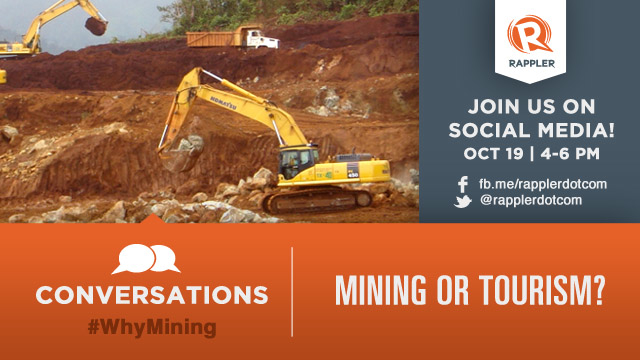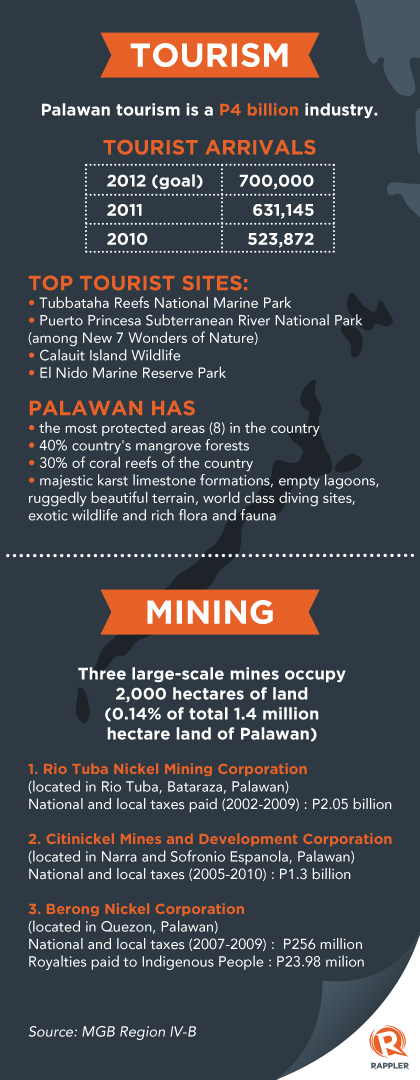SUMMARY
This is AI generated summarization, which may have errors. For context, always refer to the full article.

MANILA, Philippines – Join the #WhyMining online discussion on Friday, October 19, for a Twitter conversation on mining and its economic benefits.
From 4 p.m. to 6 p.m. and using the hashtag #WhyMining, representatives of business, industry, environmental, non-government groups, students and others who have a stake in or opinion on the mining industry will discuss whether, in some parts of the Philippines, it is better to pursue mining or tourism, or other economic activities.
The conversation is a take-off from the recently signed mining rules, which demand that no-go-areas or those banned from mining be identified. Miners are anxious that their investments will be put to waste if their current operations will be part of these “no-go” areas.
Aside from mining, alternative economic activities include tourism and agriculture.
This conflict is most passionately debated in the case of the island province of Palawan, also the focus of Friday’s Twitter conversation. Palawan hosts both profitable mining activities and pristine tourism areas.
No-go areas
Palawan is likely to be included in the no-go areas due to the richness of its biodiversity.
The island province west of the country currently has the most number of protected areas (8) and a huge portion of the country’s mangrove forests (40%) and coral reefs (30%).
Huge deposits of nickel and other minerals also remain largely untapped in the southern part of the province.
Currently, there are 3 laws protecting Palawan’s biodiversity – the Strategic Environmental Plan for Palawan, the National Integrated Protected Areas System (NIPAS) and the Mining Act of 1995.

For tourism
Taking advantage of the archipelagic location of the Philippines and its 7,107 islands, anti-mining and environmental groups pointed to tourism as one of the more viable and ideal alternatives for bolstering economic development.
Citing Palawan’s capital Puerto Princesa City as a stellar example, convenor of anti-mining group Save Palawan Movement Gina Lopez stressed that tourism is a viable alternative to mining. Puerto Princesa is the 10th top tourist destination in the Philippines with over 500,000 visitors in 2011, according to the Department of Tourism.
Lopez cited beautiful sites currently being mined “which should never have been mined,” including a rice granary in Narra in Palawan. Save Palawan Movement is keen in putting a stop on all of the mining operations in Palawan through a signature campaign.
Puerto Princesa Bishop Pedro Arigo shared Lopez’s sentiments. He said that mining is no longer needed in Palawan because of the boom of tourism in the province following the recent declaration of the Puerto Princesa Subterranean River as part of the New Seven Wonders of Nature.
“We don’t need mining because tourism alone, using the pristine beauty of nature of Palawan creates livelihood for the people without destroying the environment,” Bishop Arigo said.
According to Puerto Princesa Mayor Edward Hagedorn, Palawan tourism currently generates approximately Php 4 billion. Tourism revenue of the country amounts to $2.9 billion in 2011.
For mining
There are areas that are “not suitable for picnics eco-tourism,” stressed Gerardo Brimo, president of Nickel Asia Corp, which operates in Bataraza in south Palawan.
For areas that have a lateritic soil not suitable for agriculture and biodersity, mining activity “does not and will not affect agriculture, fishing and eco-tourism in Palawan,” Brimo stressed in his speech in March.
Three of the large-scale miners operating in Palawan are Rio Tuba Nickel Mining Corporation, Citinickel Mines and Development Corporation and Berong Nickel Corporation. All 3 operate in the southern part of the island, far from known tourist spots, according to the Chamber of Mines in the Philippines.
Brimo also highlighted the earnest effort of the mining industry and their contribution to local development of host communities citing reforestation activities and assistance to indigenous people among others.
Philex Mining Corp. chair Manny V. Pangilinan had acknowledged the importance of tourism but reiterated the clearer significance of mining.
“Tourism is certainly an option to consider. However, most mining sites are not ideal for tourism,” Pangilinan had said, citing Philex’s Padcal and Surigao mines lacking “features of an attractive tourist site” as examples.
What’s your take in this debate? – Rappler.com
More on #WhyMining:
- Shaping the future of mining
- EO: No new mining contracts
- The Mining EO: A mixed bag
- Mining E.O. not perfect, but very good
- CONVERSATIONS: What are your thoughts on the mining EO? #WhyMining
- Mining E.O. pits gov’t vs local execs
Add a comment
How does this make you feel?
There are no comments yet. Add your comment to start the conversation.